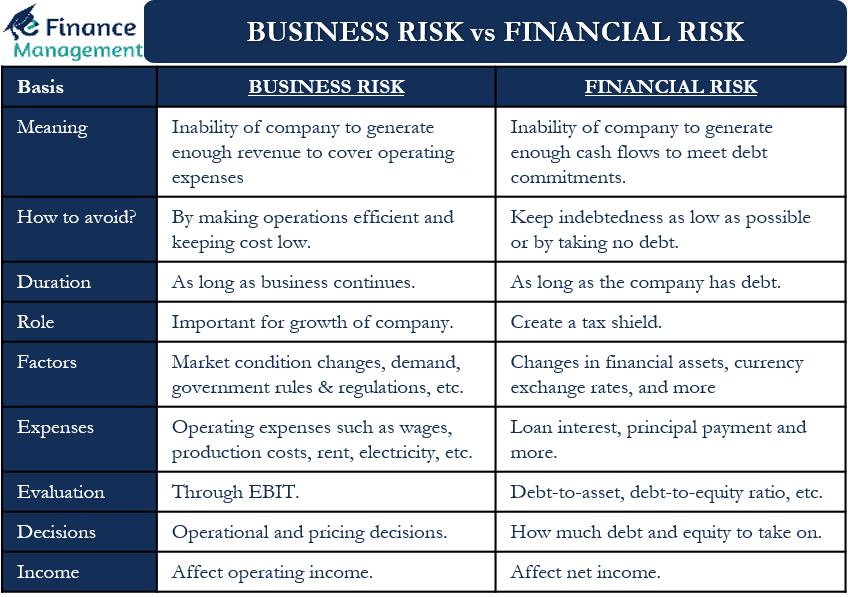Risks are everywhere, especially in a business. A company has to deal with many risks, and two of the most important risks are business and financial risks. Yes, both are different types of risks. People confuse them and use them to mean the same thing. But, when it comes to technicality, both are very different. Therefore, it is very important for investors, entrepreneurs, executives, and managers to know, understand, and appreciate the differences between Business Risk vs. Financial Risk.
Before we discuss the distinctions between Business Risk vs. Financial Risk, let us give you an idea of the two risks.
Business Risk vs. Financial Risk – Meaning
Simply put, financial risk refers to a situation in which a company is unable to manage its loan or debt. Business risk arises when a company is unable to generate enough sales to cover its operating costs. We can also say that financial risk means that the company cannot meet its debt obligations—the more debt a company takes, the more financial risk it takes. A firm may fail to work as a profitable entity in business risk.
Now that you have an idea of two risks, let’s look at the differences between Business Risk vs. Financial Risk.
Business Risk vs. Financial Risk – Differences
The following explains the differences between Business Risk vs. Financial Risk:
What do they Mean?
Business risk is the inability of a company to generate enough revenue to cover its operating expenses. Financial risk means the inability of a company to generate enough cash flows to meet its debt commitments.
Concern
Business risk relates to keeping a firm operational. On the other hand, financial risk relates to keeping a company solvent and liquid. Or we can say that business risk relates to operational leverage, while financial risk relates to financial leverage. Also, business risk relates to the company’s investment policy, while financial risk relates to investment policy and capital structure.
How to Avoid or Minimize?
A company cannot avoid business risk. It can only minimize business risk by making its operations efficient and keeping its costs low. To minimize financial risk, a company must make efforts to keep its indebtedness as low as possible. A company, however, can avoid financial risk if it takes no debt.
Duration
A company cannot completely avoid business risk, so this risk is inherent. Since a company can avoid financial risk, it remains so long as the company has debt on its balance sheet.
Role
Business risk is important for the growth of a company. Financial risk also helps a company to grow. Moreover, taking on debt helps maximize returns by creating a tax shield. Since interest on debt is an expense, it reduces income and thus income tax.
Factors
The business risk may increase due to changes in market conditions, demand, customer requirements, government rules, and regulations, etc. On the other hand, financial risk arises due to changes in financial assets, currency exchange rates, interest rate changes, and more.
Expenses
Business risk refers to operating expenses such as wages, production costs, rent, electricity, etc. Financial risk refers to loan interest, principal repayment, and more.
How to Evaluate?
One can evaluate business risk by considering the company’s earnings before taxes or EBIT. We can use the debt-to-asset ratio, the interest coverage ratio, the debt service coverage ratio, or the debt-to-equity ratio to evaluate financial risk.
Include Other Risks
Business risks also include other types of risks, such as compliance risks, strategic risks, reputation risks, etc. Financial risks include liquidity risks, equity risks, credit risks, market risks, exchange rate risks, and much more.

Decision
Business risks include operational and pricing decisions. On the other hand, financial risks consist of deciding how much debt and equity capital to take on.
Income
Business risks affect operating income, while financial risks affect net income.
Business Risk vs. Financial Risk – Relationship
Although both business and financial risks are different, they are also related to each other in some ways.
Both risks serve as a warning sign that something is wrong with the firm. So if any indicator, such as EBIT (earnings before interest and taxes), debt-to-equity ratio, or any other indicator, shows a deterioration, it should be seen as a red flag. Management must then make efforts to minimize the risk.
Another relationship between the two is that financial risk is part of business risk. Since business risk is the risk of carrying a business, it would not be wrong to call financial risk part of it. So, if a company eliminates or minimizes financial risk, it would also help reduce financial risk.
Final Words
Risks are an essential part of doing business, and therefore certain risks are unavoidable. Therefore, companies must make efforts to minimize risks. Business risks have a broader scope, and it would not be wrong to call financial risks part of business risk. So, if a company can avoid or minimize financial risk, it would also help reduce business risk.
Frequently Asked Questions (FAQs)
We use operating leverage to calculate business risk, and for calculating financial risk, we use financial leverage.
Financial risks can be avoided by keeping debt to a minimum.
Liquidity risk and currency risk are examples of financial risks.
Business risk is unavoidable, so it will exist as long as the business exists.

